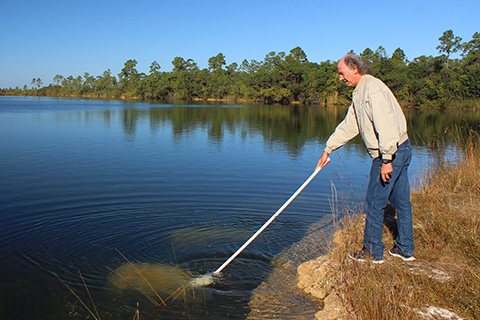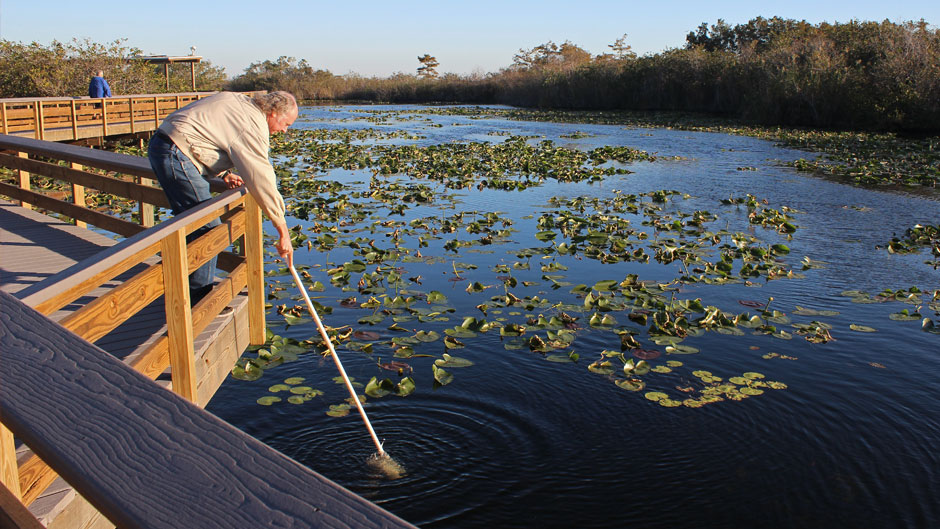In less than a 20-minute drive west, Larry Brand leaves Miami’s suburban sprawl and reaches the Everglades, where he’s been tracking the toxic algal blooms that are increasingly assaulting the diverse ecosystem, threatening South Florida’s water supply, fishing industry, tourism and even health.
A specialist in the ecology of algae and phytoplankton, Brand has been making this early-morning trip almost every month for 20 years to sample the photosynthetic organisms that are at the base of the food chain.
“If there were no algae in the ocean, there wouldn’t be any other life either,” notes the professor of marine biology and ecology at the University of Miami’s Rosenstiel School of Marine and Atmospheric Science.
Over two decades of dipping a homemade test pole—a one-liter bottle nestled into a sawed-off chunk of PVC pipe—in the water at different sites, Brand has found that some algae species toxic to fish and other vertebrates, including humans, are becoming more prevalent.
He blames man-made activities, including run-off from agriculture—particularly sugarcane farms—home garden fertilizers, and sewage, releasing excessive nutrients in South Florida’s marine and freshwater ecosystems. Some of the nutrients, such as nitrogen and phosphorus, overfeed algae, especially during the rainy season, and the algae bloom.
Inherently found in the world’s more polar regions, which are naturally rich in algae nutrients, blooms are typically rare in South Florida.
“The ones we’re getting in Florida, in the tropics, that’s clearly not natural,” Brand said. “If you end up with excess nutrients on coral reefs, the algae will overgrow the reefs and kill them. So the fact that you even have coral reefs off the coast of Florida, that tells you: it’s naturally a very low-nutrient environment.”
Too much algae generates huge amounts of organic matter and, when that sinks to the ocean floor, the bacteria that eat the organic matter remove the oxygen from the water.
“If you take out all the oxygen, everything else dies,” said Brand.
A changing climate is having indirect effects on toxic algal blooms. The warmer temperatures accelerate the hydrological cycle by evaporating more water, which produces more rainfall and, in turn, more runoff. The surplus nutrients and toxic algae species are being flushed out of the watershed faster, through the Everglades and eventually into the ocean.
Algae species vary in their toxicity. A toxic species in New England, for example, “will kill you within hours,” said Brand.
 On the other end, Brand said, some of the algal blooms in South Florida won’t cause any short-term effects in humans but, after gradual, long-term exposure, can surface as cancers, neurodegenerative diseases, and organ damage. Through a process called biomagnification, each step in the food chain accumulates higher concentrations of toxins and lipid-soluble compounds, which are difficult for vertebrates to eliminate through their normal waste filtration systems.
On the other end, Brand said, some of the algal blooms in South Florida won’t cause any short-term effects in humans but, after gradual, long-term exposure, can surface as cancers, neurodegenerative diseases, and organ damage. Through a process called biomagnification, each step in the food chain accumulates higher concentrations of toxins and lipid-soluble compounds, which are difficult for vertebrates to eliminate through their normal waste filtration systems.
The well-known Florida red tide is caused by a certain type of algae called Karenia brevis, which produces brevetoxin, a large complex molecule that damages the neurons, or nerve cells, in vertebrates.
As toxic algal blooms spread in the water, shellfish, for example, which feed by filtering algae out of the water, can’t digest these large compounds so they accumulate in the shellfish’s lipid, or fat, tissues, resulting in high concentrations of brevetoxin in the animal. The toxin doesn’t, however, affect the shellfish; it only affects vertebrates.
“As a result, you get massive fish kills on the west coast of Florida where the whole harbor was completely filled with dead fish floating to the surface,” Brand said, pointing to a photo of a sea of dead fish interrupted only by boardwalks and small boats during a red tide event earlier this year.
Dolphins in the Gulf of Mexico are eating these fish, packed with brevetoxin, and are dying. Humans, too, are feeling the effects.
“What’s interesting is, if you look at the hospital records in the area during times of red tide, you see about a 40 percent increase of people going for gastrointestinal disorders, which I suspect is from these sub-lethal doses of brevetoxin they’re getting by eating the local fish,” said Brand.
Another point of concern for Brand are cyanobacteria, also known as blue-green algae, which have low levels of a compound called BMAA. The compound has a similar molecular structure to serine, an amino acid that serves as a building block for certain proteins in the body. Transfer RNA (ribonucleic acid), the molecular tool involved with synthesizing new proteins, mistakes BMAA for serine and the protein doesn’t form the proper three-dimensional structure, Brand said.
“First, the misfolded protein now doesn’t do what it’s supposed to, as an enzyme or some other protein. Second, it gets tangled up, which is characteristic of neurodegenerative diseases,” said Brand.
Neurodegenerative diseases, such as Alzheimer’s, Parkinson’s, and ALS, are referred to as the tangle diseases because of the distinctive protein tangles in the brain. As these protein tangles of BMAA molecules accumulate, eventually those neurons become so clogged that they die and cannot be replaced.
“So if you end up with more BMAA in your diet as it biomagnifies up the food chain, you’re accumulating more of these protein tangles more quickly and your chances for getting these neurodegenerative diseases go up,” Brand said, referencing epidemiological studies on people who live near lakes with cyanobacteria blooms.
When not at one of his approximately 100 freshwater, brackish, and saltwater sample sites across South Florida, Brand is teaching four courses at the Rosenstiel School and recently returned from teaching an undergraduate field course in ecology in the Galapagos Islands.
The park’s tight restrictions on tourist activities and number of visitors to the Galapagos has helped to protect some of the most pristine and unique natural areas on the planet. Protecting natural areas, Brand believes, is also more economical and can be considered in South Florida’s efforts to protect what’s left of the Everglades, whose eastern boundary used to almost reach the Atlantic coast.
“It’s 10 to 100 times more expensive to restore an already-destroyed ecosystem than it is to protect the natural areas you have left at that point,” said Brand. “But you’ll never get it back to what it once was.”
As Brand leaves the 5,000-year-old “river of grass,” christened by the late environmentalist and author Marjory Stoneman Douglas, he leaves behind a swath of South Florida’s vanishing mangroves, marshes, tropical hardwood, cypress tree, and pine rockland forests, where anhingas, alligators, crocodiles, pelicans, manatees, turtles, panthers, snakes, and lots of mosquitoes make their homes.
And there, as he reaches the western edge of civilization, the carefully labeled bottles of algae-filled water in a cooler in the trunk of his van, he passes a supreme irony: Bus stops and sidewalk benches, painted with pelicans and hardwood hammocks, sitting alongside housing subdivisions with names evoking the natural ecosystems they are displacing.

